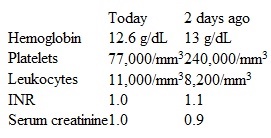A 62-year-old hospitalized man is evaluated for new-onset, right lower extremity pain. The patient underwent bypass surgery for 3-vessel coronary artery disease 2 months ago. He arrived at the emergency department 2 nights ago due to recurrent chest pains. At that time, ECG showed sinus rhythm with no ST-segment changes, but cardiac troponin I levels were elevated. The patient was initiated on unfractionated heparin, antiplatelet agents, a beta blocker, and a nitrate. A coronary angiogram was performed via the radial artery; it revealed graft insertion site stenosis and was treated with stenting. Postintervention echocardiography revealed left ventricular ejection fraction of 50% with no regional wall motion abnormalities. This morning, the patient had new, sudden-onset, right lower extremity pain. He has never had pain in that extremity before. The patient has a history of hypertension, hyperlipidemia, and type 2 diabetes mellitus. Current medications include aspirin, clopidogrel, rosuvastatin, metoprolol, losartan, isosorbide mononitrate, basal-bolus insulins, and subcutaneous heparin at a prophylactic dose. The patient is a former smoker with a 30-pack-year history. Temperature is 37.6 C (99.7 F) , blood pressure is 138/84 mm Hg, pulse is 96/min, and respirations are 18/min. Physical examination reveals normal jugular venous pressure, clear lungs, no heart murmurs, and a soft, nontender abdomen. The right leg is tender and cool to the touch when compared to the left leg. Right lower extremity distal pulses are diminished, but capillary refill is intact. Left leg examination is normal with the exception of healed scars from previous saphenous vein harvesting. Neurological examination is normal. Laboratory results are as follows: Immunoassay for heparin-induced thrombocytopenia antibody returns positive. His condition improves with treatment. Which of the following is the most accurate statement regarding heparin use and risk of recurrence of this patient's current condition?
Immunoassay for heparin-induced thrombocytopenia antibody returns positive. His condition improves with treatment. Which of the following is the most accurate statement regarding heparin use and risk of recurrence of this patient's current condition?
Definitions:
Business Combination
The process of merging two or more entities into one, through acquisitions or other means, for strategic, economic, or operational benefits.
Acquisition-Date Fair Value
The valuation of an acquired company's assets and liabilities at their fair market value on the acquisition date.
Voting Equity Interests
Shares or stock in a company that grant the holder the right to vote on corporate matters, like electing the board of directors.
Consolidated Financial Statements
Financial statements that aggregate the financial position, results of operations, and cash flows of a parent company and its subsidiaries into one document, as if the group was a single entity.
Q19: A 34-year-old man is brought to the
Q38: A 35-year-old man comes to the office
Q303: A 65-year-old man is brought to the
Q522: A 25-year-old man comes to the employee
Q710: A 25-year-old college student comes to the
Q721: A 37-year-old woman comes to the office
Q919: The patient is diagnosed with major depressive
Q975: A 3-week-old male infant with Down's syndrome is
Q1036: A previously healthy 13-month-old boy is brought
Q1056: A 51-year-old man comes to the office